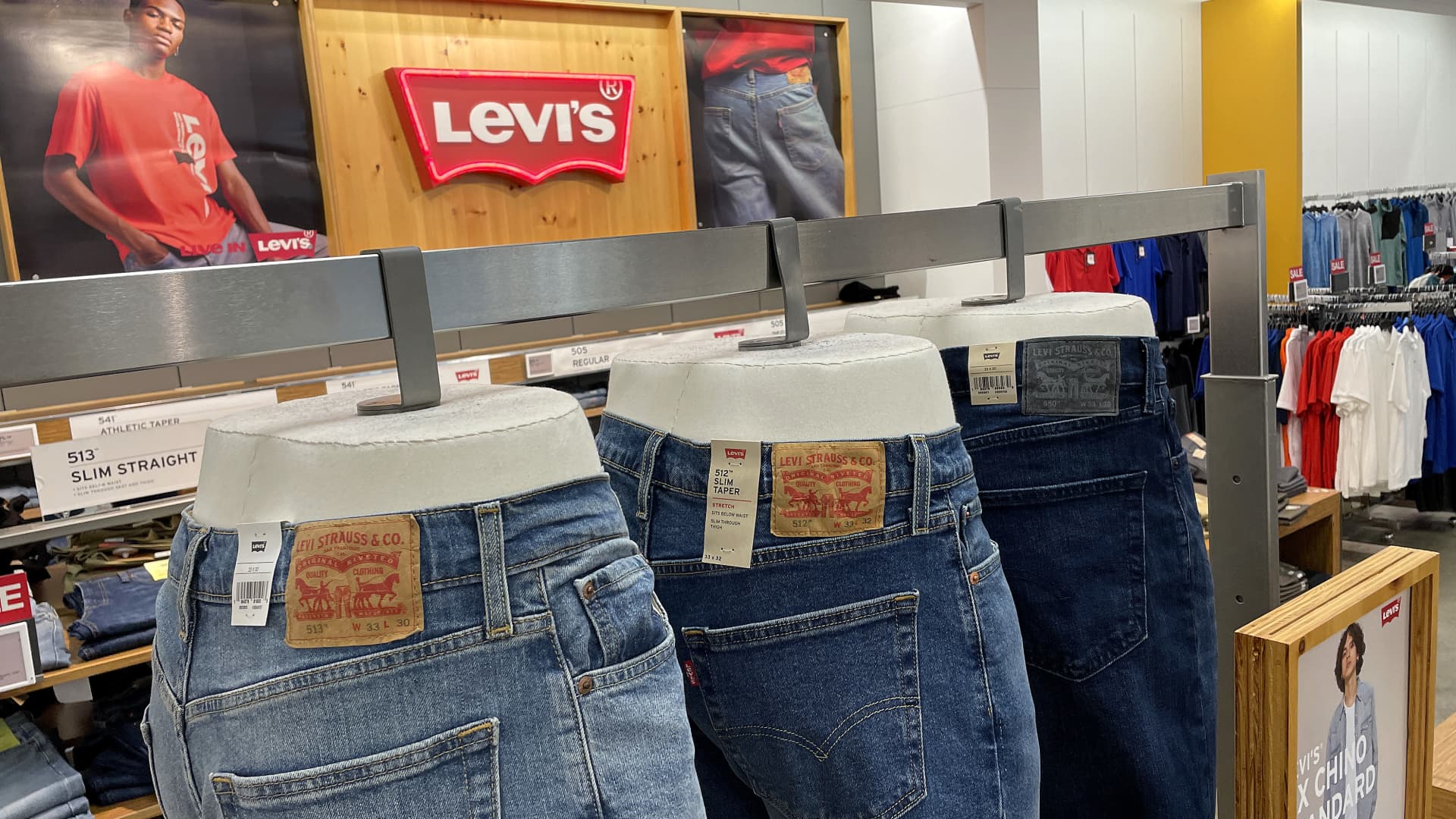Levi Strauss, which has long relied on wholesalers like Macy’s and Kohl’s to drive its business, is now doing nearly half of its sales through its own website and stores, the company said Wednesday when reporting fiscal first quarter earnings.Â
In the three months ended Feb. 25, direct-to-consumer sales made up a record 48% of overall sales at Levi’s, up from 42% in the year-ago period and 25% higher on a two-year basis, the retailer said.Â
The shift is a boon for Levi’s profits. But it raises questions about the company’s relationships with its wholesale partners and whether it will hurt those retailers as they grapple with their own existential challenges.
Levi’s also beat Wall Street’s earnings and revenue estimates and raised its full-year guidance. Shares rose as much as 10% in extended trading.
Here’s how the blue jeans maker did in its first fiscal quarter compared with what Wall Street was anticipating, based on a survey of analysts by LSEG, formerly known as Refinitiv:
- Earnings per share: 26 cents adjusted vs. 21 cents expected
- Revenue: $1.56 billion vs. $1.55 billion expected
The company swung to a net loss of $10.6 million, or 3 cents per share, during the quarter, compared with a net income of $114.7 million, or 29 cents per share, in the year-ago period. Excluding one-time costs related to Levi’s restructuring, the company reported earnings per share of 26 cents, ahead of Wall Street’s estimates.Â
Sales fell to $1.56 billion, down about 8% from $1.69 billion a year earlier. The sales slump was primarily attributed to a shift in Levi’s wholesale orders, which boosted profits by about $100 million in the year-ago period.Â
Levi’s still expects full-year sales to rise between 1% and 3% as it contends with a slowdown in discretionary spending and an uncertain economy. But it anticipates profits will be higher than it previously thought. The retailer now expects adjusted earnings per share to be between $1.17 and $1.27, up from a previous range of $1.15 to $1.25.Â
Analysts had expected sales to grow 2.4% on a full year basis and earnings per share of $1.21, according to LSEG.Â
For the last couple of years, Levi’s has been moving away from wholesalers and doing more and more of its sales through its own stores and website. Selling directly to consumers is better for Levi’s profits and gives it better data on its customers and their shopping patterns.Â
Perhaps more importantly, shifting away from wholesalers also gives Levi’s greater control over its own destiny and reduces its exposure to department stores, which are continuing to shrink and face an uncertain future in the U.S.Â
In late February, Macy’s â a key wholesale partner for Levi’s â announced it would close 150 stores as activist investors from Arkhouse Management look to buy the department store and take it private. The firm primarily invests in real estate and looks to be more interested in monetizing Macy’s sprawling store footprint than running a retail business.Â
In an interview with CNBC, CEO Michelle Gass â who took the helm of Levi’s about two months ago â said wholesale continues to be an important part of the company’s strategy. If Macy’s store closures or other challenges to department stores affects Levi’s business, she expects direct-to-consumer sales will offset those losses.Â
“We work very closely with our key customers because we’re important to them, they’re important to us, and strategically, wholesale is critical for us to amplify reach to the consumer,” said Gass. “While there are pressures, these wholesale customers serve millions of consumers and so there’s still a lot of opportunity to drive market share within that channel.”Â
Levi’s previously said it’s working to get direct-to-consumer sales to account for 55% of all sales, but if that number can get higher, the company is “all for it,” said finance chief Harmit Singh.Â
In the meantime, Gass said Levi’s is working “closely” with its key wholesale customers to ensure the brand is showing up in the “absolute best way.”Â
During the quarter, global wholesale revenues were down 9% compared to the prior year when adjusted for the shift in wholesale orders that happened in the year-ago period.Â
That weakness was driven by Europe, which Gass said saw a “tough” quarter.Â
“As we look forward, we are feeling optimistic. Our pre-books for the second half in Europe wholesale are positive based on the innovation and fashion that we’re bringing,” said Gass.Â
Levi’s has also been in the process of transforming itself into a retailer that does a lot more than just sell jeans. It’s working to offer more skirts, dresses and tops, and wants to be viewed as a denim lifestyle business â not just a blue jeans company.Â
During the quarter, sales of things like denim skirts, dresses and tops were up 19% in Levi’s direct-to-consumer channel, said Gass. The products also performed well in wholesale, she said.Â
Levi’s efforts come at a time when consumer spending for discretionary products like clothes and accessories has been under pressure as shoppers look to use their extra dollars on things like eating out and traveling or paying down debt.Â
In late January, Levi’s said it would cut 10% to 15% of its global corporate workforce, which is expected to save the company about $100 million during the fiscal year.
Read the original article here
